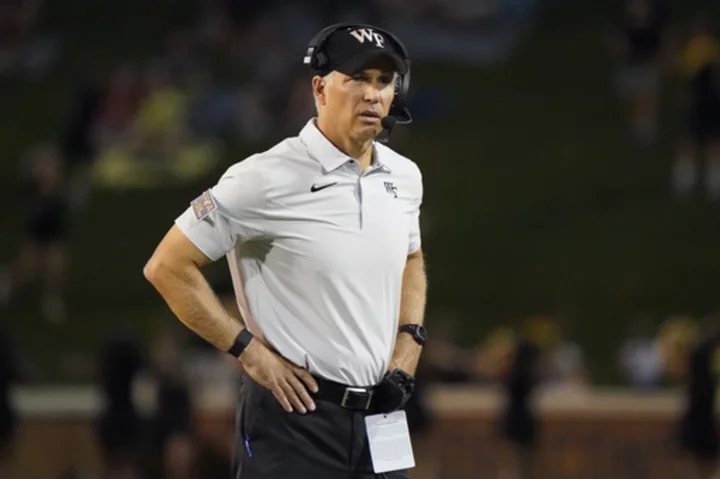AMELIA ISLAND, Fla. (AP) — The Atlantic Coast Conference emerged from three days of spring meetings at a posh, oceanside resort with one resolution: the formalization of tiebreaker rules for the league’s new, no-division format.
Most everything else discussed behind closed doors remained secretive works in progress, most notably how the league plans to close the financial gap on college football’s preeminent powerhouses: the Big Ten and the Southeastern Conference.
The ACC is a distant third in annual payouts to its members, a spot that was both chastised and celebrated at times during the meetings. The league remains ahead of the Pac-12 and the Big 12, conferences that are losing flagship institutions next year, but far back of the Big Ten and SEC.
It’s a less-than-ideal position that prompted Florida State athletic director Michael Alford in February to make a public plea for change and float the idea of joining a growing list of schools — Oklahoma, Texas, UCLA and USC — that announced plans to change conferences in the past two years to increase their bottom line. Three months later, Alford softened his stance and insisted he’s “optimistic about the future.”
“I’m thrilled with the work and the direction that it’s going,” Alford said this week. “Step in the right direction. We’re not going to ever cover the entire gap, but it will allow you to be competitive.”
Most in attendance said they believe a revised revenue-distribution model would help the most successful teams beginning with the 2024-25 school year. The proposal would send a larger share of postseason revenue to the teams participating in those events rather than dividing it equally.
The tweak would coincide with the start of the expanded (and more lucrative) College Football Playoff. If you make the CFP, you get a larger share. The men’s NCAA Basketball Tournament also would be divvied up based on performance, with deeper runs being rewarded.
Alford suggested the revisions could lead to more than $10 million annually in extra revenue for a school. The proposal still needs to be approved by ACC presidents and chancellor. League Commissioner Jim Phillips said a vote could be weeks away.
“It’s too early to tell,” Phillips said. “We’re not that far down the road. We’re not ready to announce this thing in the next week or so. … But they’ve seen it and it’s got really good traction.”
Several coaches and ADs praised it as progress.
“If you base it on your investment in football and winning football, I think we’d probably end up on the good end of that,” Wake Forest football coach Dave Clawson said. “Control the controllables. That’s what we control.”
The new model would have no effect on the equally distributed revenue from the league’s television contracts, meaning no school would not get any less than it’s currently getting.
The ACC has yet to report its 2021-22 revenue distribution, but it’s expected to land around $43 million per school. That’s roughly $30 million less than the Big Ten and the SEC.
Any program $30 million short of its competitors on an annual basis could struggle to keep pace in arms races that involve recruiting budgets, facility improvements, support staffs and coaching salaries.
“Our schools have done a great job with the resources they’ve been given,” Phillips said. “Should we be in this position? When we decided to do this deal in 2016, we had 15 schools that I think raced to the opportunity to have a network, to lock in for 20 years and all the rest of that, and I understand times change and you adjust. It’s like anything else in life; it’s not always a straight line. So we’re figuring this thing out.”
And trying to keep the league intact.
To bolt the ACC, a school would need to pay an exit fee of three times its annual revenue (approximately $120 million) and would need to navigate the grant in media rights to the ACC to be able to broadcast future games.
Several reports suggested that as many as seven schools — Clemson, Florida State, Miami, North Carolina, North Carolina State, Virginia and Virginia Tech — had discussions about breaking the ACC’s grant-of-rights deal. The document ties the conference together through 2036.
“I think you got to have more than one healthy neighborhood,” Phillips said. “You have to have a healthy infrastructure. … You want national competition from coast to coast, not just regional competition.
“But at the end of the day, how much do you need to be a national champion in football and basketball and in our other sports? Do you have to be at the very top level? Do you have to spend the most to be the best? I don’t know that there has been an equation that has kind of connected the two. It certainly is helpful and it certainly allows you a greater chance.”
In the meantime, the ACC has little choice but to settle for third place in the ever-changing landscape of college football. There’s no guarantee it stays there or stays together.
“We just need to be competitive,” Alford said. “We’re the third-best media agreement right now; we want to stay the third best. We’ve been able to compete with them being the third-best media agreement. A lot of comes down to choices we will make with funding.”
___
AP college football: https://apnews.com/hub/college-football and https://twitter.com/AP_Top25

